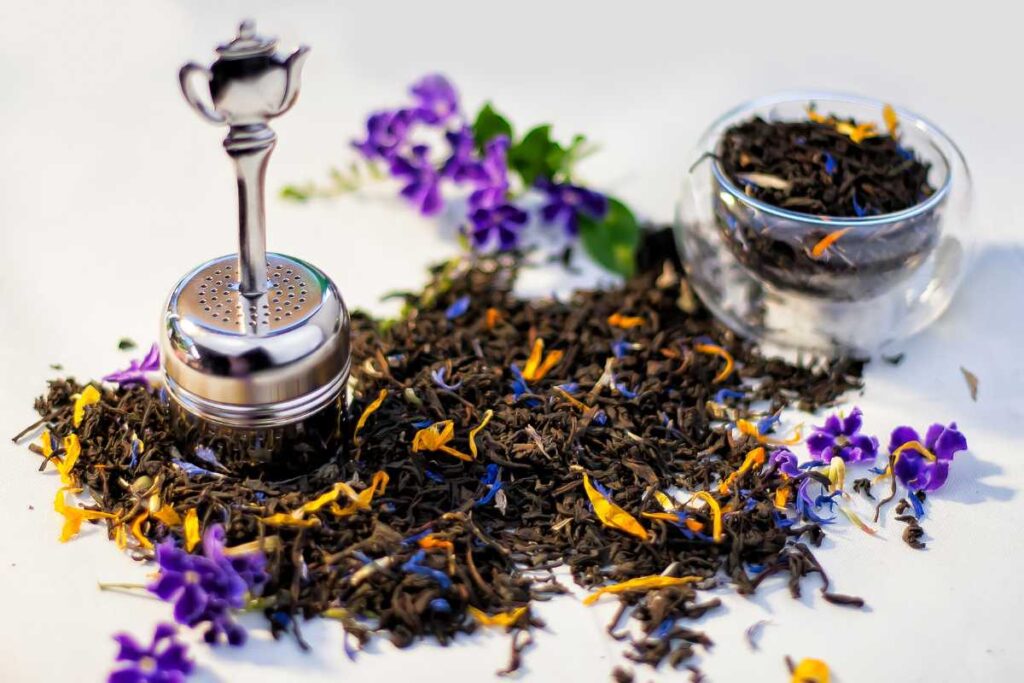Discovering Earl Grey Tea: History, Health Benefits, and Brewing Tips
Earl Grey Tea – A Classic Blend with a Twist
Earl Grey tea is a classic blend of black tea infused with oil from the bergamot orange. The exact source of Earl Grey tea remains unknown, but it is believed to have originated in China and was later popularized by British tea masters. Today, Earl Grey tea remains a popular choice among tea drinkers worldwide and is enjoyed both hot and cold.
The tea blend is named after Charles Grey, the 2nd Earl of Grey, who was a British Prime Minister in the early 19th century. It’s unclear how this particular blend became associated with Lord Grey, but it’s said that he received the recipe as a gift from Chinese tea masters during his travels.
There are many variations of Earl Grey teas available today, including Harrogate Earl Grey, Stash Tea Double Bergamot Earl Grey Black Tea, and Sons Earl Grey Supreme. Twinings also offers an extensive range of Earl Grey blends that cater to different tastes and preferences.
Lady Grey is another variation of Earl Grey tea that includes additional flavors such as lemon and orange peel. This variation was created by Twinings in honor of Lady Mary Elizabeth Grey, wife of Charles Gray.
Earl grey teas can be found at various prices depending on where you purchase them. Starbucks offers their version for around $3-$4 per cup while other brands may vary in price depending on quality or quantity.
The History of Earl Grey Tea and Its Popularity Today
Named after Charles Grey, the 2nd Earl Grey, who was a British Prime Minister in the 1830s, Earl Grey tea is one of the most popular tea blends in the world today. The exact origin of this famous tea blend is unknown, but it is believed that the recipe was given to Earl Grey by a Chinese mandarin as a gift for saving his son’s life. Despite its mysterious origins, the popularity of Earl Grey tea has only continued to grow over time.
Earl Grey Tea’s Origins
Earl Grey tea has an intriguing history that dates back to early 19th century England. While it is unclear exactly when this beloved tea blend was first invented, we do know that it quickly became popular among English aristocrats during this time period. In fact, Howick Hall, which is the family seat of the Earls Grey, has been producing its own blend of Earl Grey tea since the 1800s.
While there are many different theories about where Earl Grey tea originally came from, most experts agree that it was likely inspired by traditional Chinese black teas. Some have even suggested that it may have been created specifically for Lord Charles Grey himself as a way to make his local water supply more palatable.
The Popularity of Earl Grey Tea Today
Today, Earl Grey tea can be found in nearly every supermarket and specialty food store around the globe. This classic black tea blend features a distinctive citrus flavor thanks to its use of bergamot oil – an essential oil derived from the rind of bergamot oranges.
In addition to traditional blends like Howick Hall’s original recipe, there are now countless variations on this classic theme available for consumers to enjoy. Lady grey tea is one such variation that includes additional ingredients like lemon and orange peel.
Despite all these variations and innovations over time, however, one thing remains constant: Earl Grey tea is still one of the most beloved and iconic tea blends in the world. Whether you prefer it hot or iced, sweetened or unsweetened, there’s no denying that this classic black tea blend has earned its place among the pantheon of great teas.
Health Benefits of Earl Grey Tea: Boosting Mental Alertness, Immunity, and More
Boosting Mental Alertness with Earl Grey Tea
Earl Grey tea is a popular caffeinated beverage that has been enjoyed for centuries. One of the main benefits of this tea is its ability to boost mental alertness and improve cognitive function. This is due to the caffeine content in Earl Grey tea, which can help increase focus, attention, and energy levels.
While coffee is often the go-to source of caffeine for many people, Earl Grey tea offers a lower caffeine content than coffee. This makes it a great alternative for those who want to reduce their caffeine intake but still reap the benefits of increased mental alertness. In fact, one cup of Earl Grey tea contains approximately 40-60 milligrams of caffeine, while an average cup of coffee contains around 95 milligrams.
In addition to its caffeine content, Earl Grey tea also contains L-theanine, an amino acid that has been shown to have calming effects on the brain. This means that drinking Earl Grey tea can help promote relaxation and reduce anxiety while still providing a boost in mental clarity and focus.
Improving Immunity with Antioxidants
Another benefit of drinking Earl Grey tea is its high antioxidant content. Antioxidants are compounds that can help protect your cells from damage caused by free radicals, which are unstable molecules produced by environmental factors like pollution and radiation.
The antioxidants found in Earl Grey tea come from the bergamot oil used to flavor the tea. Bergamot oil contains compounds called polyphenols, which have been shown to have anti-inflammatory properties and may help reduce the risk of chronic diseases like heart disease and cancer.
Drinking Earl Grey tea regularly can also help improve immunity by strengthening your body’s natural defense mechanisms. The antioxidants in this tea can help fight off harmful pathogens and prevent infections from taking hold.
Choosing High-Quality Earl Grey Tea
When choosing an Earl Grey tea product, there are other factors beyond taste to consider. Look for product certifications such as Savesnap EBT and Climate Impact Partners to ensure that the tea has undergone internal reductions in emissions and has a lower climate impact.
It’s also important to choose high-quality tea leaves that have been properly sourced and processed. Some tea brands may use low-quality ingredients or additives that can diminish the health benefits of Earl Grey tea.
Risks of Drinking Earl Grey Tea: Potential Side Effects to Be Aware Of
Caffeine Content: Potential Side Effects of Drinking Earl Grey Tea
Earl Grey tea is a popular beverage that is enjoyed by many people all over the world. However, it is important to be aware of the potential risks associated with drinking this tea. One of the primary concerns with Earl Grey tea is its caffeine content. While caffeine can provide a boost of energy and focus, it can also cause negative side effects in some individuals.
Insomnia, nervousness, and restlessness are just a few of the potential side effects that may occur as a result of consuming too much caffeine. Caffeine can also increase heart rate and blood pressure in some people. It is recommended that individuals limit their intake of Earl Grey tea if they are sensitive to caffeine or have any underlying health conditions that may be exacerbated by its consumption.
Dehydration: Diuretic Properties
Another potential risk associated with drinking Earl Grey tea is dehydration. This is due to the diuretic properties found in black tea, which can cause an increase in urine output and lead to fluid loss from the body. While moderate consumption of Earl Grey tea should not cause significant dehydration for most individuals, those who are particularly sensitive to diuretics should exercise caution when consuming this beverage.
Allergic Reactions: Bergamot Oil
The bergamot oil used in Earl Grey tea may also pose a risk for certain individuals. Some people may experience allergic reactions after consuming bergamot oil, which can include symptoms such as hives, itching, and swelling. If you have a known allergy to citrus fruits or essential oils derived from citrus fruits, you should avoid drinking Earl Grey tea or consult with your healthcare provider before doing so.
Iron Absorption Interference: High Levels of Tannins
High levels of tannins found in black teas like Earl Grey can interfere with iron absorption from food sources. This means that regular consumption of this type of tea may increase the risk of iron deficiency anemia, particularly in individuals who are already at risk for this condition. To mitigate this risk, it is recommended that individuals consume iron-rich foods alongside their Earl Grey tea or choose alternative beverages that do not contain tannins.
Pregnancy: Caffeine Content
Finally, pregnant women should be cautious when consuming Earl Grey tea due to its caffeine content. While moderate caffeine consumption during pregnancy is generally considered safe, high levels of caffeine intake have been linked to negative outcomes such as low birth weight and preterm labor. It is recommended that pregnant women limit their intake of Earl Grey tea and other caffeinated beverages to no more than 200 milligrams per day.
Identifying the Characteristics of Earl Grey Tea as a Flavored Black Tea
Earl Grey tea is a flavored black tea that has become increasingly popular in recent years. Its unique flavor profile comes from the infusion of black tea leaves with bergamot oil, which gives it a distinct citrusy taste. In this section, we will discuss the characteristics of Earl Grey tea as a flavored black tea and introduce some of the most popular brands.
Flavor Profile
The flavor of Earl Grey tea is complex and can vary depending on the type of black tea used as a base. The bergamot oil adds a citrusy note to the blend, but it is important to note that not all Earl Grey teas are created equal. Some have stronger or more subtle flavors than others, depending on the quality of the ingredients used.
Twinings Earl Grey Black Tea
One of the most popular brands of Earl Grey tea is Twinings Earl Grey Black Tea. This brand is known for its high-quality black tea base and well-balanced flavor. The blend has been perfected over time to create an ideal balance between the strong black tea base and the subtle citrus notes from the bergamot oil.
Ahmad Tea Black Tea
Another popular brand of black tea used as a base for Earl Grey tea is Ahmad Tea Black Tea. This brand is known for its bold and robust flavor, which makes it an excellent choice for those who prefer their Earl Grey with a stronger taste. The combination of this strong base with bergamot oil creates an intense flavor profile that many people enjoy.
Brewing the Perfect Cup of Earl Grey Tea: Step-by-Step Guide
Using the Right Amount of Tea Leaves
To brew a perfect cup of Earl Grey tea, it’s crucial to use the right amount of tea leaves. Generally, one teaspoon of loose leaf Earl Grey tea per cup of water is recommended. This ratio ensures that you get the perfect balance of flavor without overpowering or diluting the taste. However, you can adjust this depending on your preference for stronger or weaker tea.
Heating Water to the Right Temperature
The next step in brewing Earl Grey tea is heating the water to just below boiling point, which is around 95°C. Boiling water can scorch the delicate tea leaves and ruin their flavor. Therefore, it’s essential to heat it to the right temperature for optimal taste.
Steeping Time Matters
The steeping time also plays a significant role in getting a perfect cup of Earl Grey tea. Steep your tea for 3-5 minutes depending on how strong you like your tea. Over-steeping can make your tea bitter and unpleasant, while under-steeping can leave you with weak and watery tea.
Understanding How Earl Grey Tea is Manufactured
Earl Grey tea gets its unique flavor from bergamot orange oil that’s added during production. The process involves withering, rolling, oxidation, and drying of black (or green/white) tea leaves before adding bergamot oil. The quality and quantity of bergamot oil used determine the strength and aroma of your Earl Grey Tea.
Making Iced Earl Grey Tea
If you’re looking for a refreshing drink during hot summer months, try making iced Earl Grey Tea! Once brewed using hot water as usual following our previous steps above, let it cool down before pouring over ice cubes in a glass jar or pitcher. Add lemon slices or mint leaves for extra freshness.
Choosing the Right Tea Leaves for Your Earl Grey Brew
Black Tea Leaves: The Traditional Choice for Earl Grey
Earl Grey tea is a classic British tea that has been enjoyed for centuries. It is traditionally made with black tea leaves, which are infused with bergamot oil to create its distinctive flavor and aroma. Black tea leaves have a robust, full-bodied flavor that pairs perfectly with the citrusy notes of bergamot.
Loose Leaf Tea: The Best Choice for Flavor Extraction
Loose leaf tea is the preferred choice. Loose leaf tea allows for better flavor extraction compared to pre-packaged tea bags. This is because loose leaf teas are not constrained by the small space in a teabag and can expand fully during steeping, allowing for more water flow and better flavor release.
High-Quality Tea Leaves: Essential for a Good Cup of Earl Grey
Using high-quality tea leaves is essential for brewing a good cup of Earl Grey. High-quality teas are picked from the best parts of the plant and processed carefully to preserve their natural flavors and aromas. When choosing your Earl Grey tea leaves, look for those that have been sourced from reputable suppliers who prioritize quality over quantity.
Tea Bags vs Loose Leaf Tea: Convenience vs Depth of Flavor
While loose leaf tea is the preferred choice for making Earl Grey, tea bags offer convenience and ease of use. However, they may not provide the same depth of flavor as loose leaf teas due to their smaller size and lower quality ingredients. If you’re looking for convenience but still want a good cup of Earl Grey, opt for high-quality total tea bags made from whole-leaf teas rather than lower quality fannings or dusts.
Amount of Tea Leaves Used: Personal Preference & Strength
The amount of tea leaves used when brewing Earl Grey will depend on personal preference and desired strength. As a general rule, 1 teaspoon (2 grams) per 8 ounces (240 ml) of water is a good starting point. If you prefer a stronger brew, increase the amount of tea leaves used or steep for longer. Conversely, if you prefer a milder cup, use fewer tea leaves or steep for less time.
Steeping Time & Water Temperature: Factors to Consider
The steeping time and water temperature are also important factors to consider when brewing Earl Grey tea. Steep for 3-5 minutes in water that has been heated to just below boiling point (195-205°F/90-96°C) for optimal flavor extraction. Over-steeping can result in a bitter taste, while under-steeping may result in a weak and watery cup.
Bergamot – The Key Ingredient in Earl Grey Tea: Types and Amounts Used
Natural Bergamot Oil vs Synthetic Flavorings
Bergamot is a type of citrus fruit that is commonly used to flavor Earl Grey tea. The essential oil extracted from the rind of the bergamot orange is what gives Earl Grey its distinctive aroma and flavor. Natural bergamot oil is typically used in higher-quality Earl Grey teas, while synthetic flavorings may be used in lower-quality blends. It’s important to note that natural bergamot oil has a more complex and nuanced flavor profile than synthetic flavorings, which tend to be one-dimensional.
Amount of Bergamot Used in Earl Grey Tea
The amount of bergamot used in Earl Grey tea can vary depending on the brand and recipe, but it typically ranges from 2% to 5% of the total tea blend. This may not seem like a lot, but even small amounts of bergamot can have a big impact on the overall taste and aroma of the tea. Some brands may use more or less bergamot depending on their desired flavor profile.
Earl Grey Teas with Real Bergamot
If you’re looking for an Earl Grey tea that uses real bergamot oil, there are several brands to choose from. Twinings, Harney & Sons, and Mariage Frères are all known for using natural bergamot oil in their blends. However, it’s always a good idea to check the ingredient list before purchasing any tea to make sure you’re getting exactly what you want.
Who Should Avoid Bergamot Tea?
While most people can enjoy Earl Grey tea without any issues, some individuals should avoid consuming large amounts of bergamot due to its potential interactions with certain medications. Bergamottin, a compound found in bergamot oil, can interfere with enzymes responsible for metabolizing many medications, including some statins and antidepressants. If you’re taking any medications, it’s always a good idea to talk to your doctor before consuming large amounts of bergamot tea or supplements.
Pairing Earl Grey Tea with Food: Best Combinations and Recipes
Earl Grey tea is a versatile beverage that pairs well with a variety of foods. From sweet to savory, there are many delicious ways to enjoy this beloved tea. In this section, we’ll explore some of the best food pairings for Earl Grey tea and share a few recipes that feature this flavorful brew.
Citrus-Based Desserts: Lemon Bars and Orange Cakes
One of the most popular flavor profiles in Earl Grey tea is its citrusy notes. These bright flavors make it an excellent pairing for citrus-based desserts like lemon bars or orange cakes. The zesty tang of the fruit complements the bergamot oil in the tea, creating a harmonious balance of flavors.
For example, try serving Earl Grey alongside lemon bars at your next brunch gathering. The tartness of the lemon filling contrasts beautifully with the floral notes in the tea, while the buttery crust provides a rich counterpoint to both. Or, serve Earl Grey with an orange cake made with fresh-squeezed juice and zest for a dessert that’s light and refreshing.
Light, Creamy Cheeses: Brie and Goat Cheese
Another great pairing for Earl Grey is light, creamy cheeses like brie or goat cheese. These cheeses have a mild flavor profile that won’t overpower the delicate nuances in the tea but still provide enough richness to complement its floral notes.
Try serving brie on crackers or sliced baguette alongside a pot of freshly brewed Earl Grey for an elegant appetizer that’s sure to impress your guests. Or crumble goat cheese over a salad dressed with vinaigrette made from steeped Earl Grey tea leaves for a unique twist on a classic dish.
Savory Pairings: Smoked Salmon or Prosciutto-Wrapped Melon
If you’re looking for something more savory to pair with your Earl Grey, smoked salmon or prosciutto-wrapped melon are both excellent options. The smoky, salty flavors of the salmon or prosciutto contrast beautifully with the tea’s floral notes, creating a complex and satisfying flavor profile.
For example, try serving smoked salmon on toast points alongside a cup of Earl Grey for a light lunch or brunch dish that’s both elegant and delicious. Or wrap cubes of fresh melon in thin slices of prosciutto and serve them as an appetizer at your next dinner party.
Recipes Featuring Earl Grey Tea
Earl Grey tea is not only a great beverage to pair with food but can also be used as an ingredient in recipes. Here are two simple recipes that feature this flavorful brew:
Earl Grey Chicken Marinade: Combine 1/2 cup brewed Earl Grey tea, 1/4 cup olive oil, 2 tablespoons honey, 2 cloves minced garlic, and salt and pepper to taste in a large bowl. Add chicken breasts and marinate for at least 30 minutes before grilling or baking.
Earl Grey Rice Pilaf: Cook rice according to package instructions but substitute half the water with brewed Earl Grey tea. Once cooked, stir in sautéed onions, garlic, diced carrots, and peas for a flavorful side dish that pairs well with roasted meats or fish.
Enjoying the Unique Flavor and Benefits of Earl Grey Tea
In conclusion, Earl Grey tea is a unique and flavorful black tea that has become increasingly popular in recent years. It offers a variety of health benefits, including boosting mental alertness, improving immunity, and aiding digestion. However, it’s important to be aware of the potential risks associated with drinking too much Earl Grey tea.
To fully enjoy the flavor and benefits of Earl Grey tea, it’s essential to choose high-quality tea leaves and brew them properly. The key ingredient in Earl Grey tea is bergamot oil, which gives the tea its distinctive citrusy aroma and taste.
When pairing Earl Grey tea with food, there are many delicious options to choose from. Some popular pairings include scones with jam and cream, lemon cake, or even spicy dishes like Indian curry.
Whether you’re a seasoned tea drinker or just starting out on your journey into the world of teas, trying Earl Grey is definitely worth considering. Its unique blend of flavors and health benefits make it an excellent choice for anyone looking for a tasty and healthy beverage option.
So why not brew yourself a cup today? Sit back, relax, and savor the rich aroma and flavor of this classic black tea. You won’t be disappointed!





